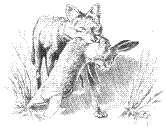Center, Internet, Wildlife Damage Management

Coyotes in the Southwest: A Compendium of Our Knowledge (Symposium Proceedings, 1995)
Date of this Version
January 1995
Document Type
Proceeding
Citation
Published in Coyotes in the Southwest: A Compendium of Our Knowledge, Symposium Proceedings, December 13–14, 1995, San Angelo, Texas
Edited by Dale Rollins, Calvin Richardson, Terry Blankenship, Kem Canon, and Scott Henke
Abstract
Coyotes (Canis latrans) live in social groups with relatively small territories or as single, non-territorial transients with large home ranges in southern Texas. Coyotes communicate and establish territories through auditory, olfactory, and visual means They consume mammals, fruits, and insects with their diets reflecting difference sin abundance and vulnerability of prey, effects of plant phenology and weather conditions. Coyotes have adapted to human exploration by avoiding humans and their control techniques. Because coyotes habituate to nonlethal control techniques (e.g. frightening devices), I suggest apply frightening devices only when coyotes are a problem. Lethal techniques likely will be most effective at resolving coyote depredations if they are applied at depredation sites and immediately before or when losses occur.


Comments
Published 1996, Austin, Texas. Used by permission